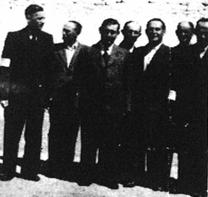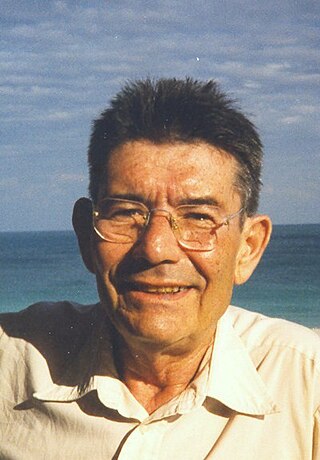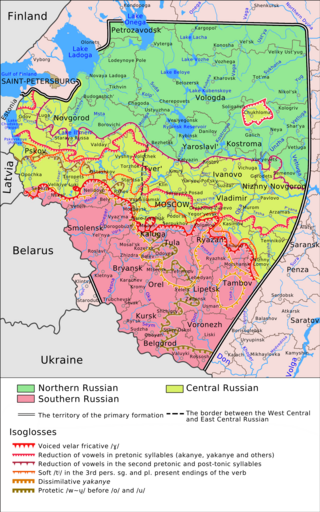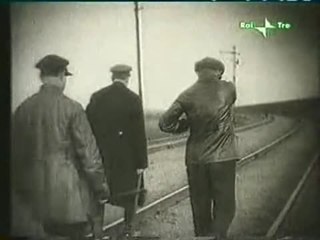Related Research Articles

A Judenrat was an administrative body established in German-occupied Europe during World War II which purported to represent a Jewish community in dealings with the Nazi authorities. The Germans required Jews to form Judenräte across the occupied territories at local and sometimes national levels.

Terezín is a town in Litoměřice District in the Ústí nad Labem Region of the Czech Republic. It has about 2,800 inhabitants. It is a former military fortress composed of the citadel and adjacent walled garrison town. The town centre is well preserved and is protected by law as an urban monument reservation. Terezin is most infamously the location of the Nazis' notorious Theresienstadt Ghetto.

Theresienstadt Ghetto was established by the SS during World War II in the fortress town of Terezín, in the Protectorate of Bohemia and Moravia. Theresienstadt served as a waystation to the extermination camps. Its conditions were deliberately engineered to hasten the death of its prisoners, and the ghetto also served a propaganda role. Unlike other ghettos, the exploitation of forced labor was not economically significant.

Theresienstadt. Ein Dokumentarfilm aus dem jüdischen Siedlungsgebiet, unofficially Der Führer schenkt den Juden eine Stadt, was a black-and-white projected Nazi propaganda film. It was directed by the German Jewish prisoner Kurt Gerron and the Czech filmmaker Karel Pečený under close SS supervision in the Theresienstadt concentration camp, and edited by Pečený's company, Aktualita. Filmed mostly in the autumn of 1944, it was completed on 28 March 1945 and screened privately four times. After the war, the film was lost but about twenty minutes of footage was later rediscovered in various archives.

The Holocaust in Estonia refers to Nazi crimes during the occupation of Estonia by Nazi Germany.

Herbert Thomas Mandl was a Czechoslovak-German-Jewish author, concert violinist, professor of music, philosopher, inventor and lecturer. He authored novels, stories and dramas that are inspired by the extraordinary events of his life.
Voices of the Children is a 1999 Emmy-Award winning documentary film written and directed by Zuzana Justman. It tells the story of three people who were imprisoned as children in the Terezin concentration camp. It was produced and shown on television in the United States.
Martin Roman was a German jazz pianist.

Russian dialects are spoken variants of the Russian language.

Cinetrain or cine-train was a documentary film project conducted across the Soviet Union in the late 1920s by director Aleksandr Medvedkin. All 60 films created in Cinetrain were considered lost until 1980, when some of them were discovered in the archives of film historian Nikolai Izvolov.

The Theresienstadt Papers are a collection of historical documents of the Jewish self-government of Theresienstadt concentration camp. These papers include an "A list" of so-called "prominents" interned in the camp and a "B-list" created by the Jewish Elders themselves. The Theresienstadt papers include two albums with biographies and many photographs, 64 watercolors and drawings from prisoners in Theresiendstadt, and the annual report of the Theresienstadt Central Library. The papers were preserved at the liberation of the camp in May 1945 by Theresienstadt librarian Käthe Starke-Goldschmidt and later loaned to the Altona Museum for Art and Cultural History in Hamburg by her son Pit Goldschmidt. The collection was opened for viewing by the public in 2002 at the Heine Haus branch of the Altona Museum.

An agit-train was a locomotive engine with special auxiliary cars outfitted for propaganda purposes by the Bolshevik government of Soviet Russia during the time of the Russian Civil War, War Communism, and the New Economic Policy. Brightly painted and carrying on board a printing press, government complaint office, printed political leaflets and pamphlets, library books, and a mobile movie theater, agit-trains traveled the rails of Russia, Siberia, and Ukraine in an attempt to introduce the values and program of the new revolutionary government to a scattered and isolated peasantry.
Hyperkino is a standardized system of referencing and annotating films on digital carriers – attaching related content and analysis to individual frames. The name of the method, Hyperkino, is based on the intertwining of the concepts of textual criticism and hypertext.
Natascha Drubek-Meyer (Drubek) is a researcher, author and editor in the area of Central and East European literature, film and media. Since 2012 Drubek has been teaching comparative literature, and film and media studies, at the Free University of Berlin (in 2020-21 as professor of the FONTE-Stiftung].

Theresienstadt was originally designated as a model community for middle-class Jews from Germany, Czechoslovakia, and Austria. Many educated Jews were inmates of Theresienstadt. In a propaganda effort designed to fool the western allies, the Nazis publicised the camp for its rich cultural life. In reality, according to a Holocaust survivor, "during the early period there were no [musical] instruments whatsoever, and the cultural life came to develop itself only ... when the whole management of Theresienstadt was steered into an organized course."
During World War II, the Theresienstadt concentration camp was used by the Nazi SS as a "model ghetto" for deceiving Red Cross representatives about the ongoing Holocaust and the Nazi plan to murder all Jews. The Nazified German Red Cross visited the ghetto in 1943 and filed the only accurate report on the ghetto, describing overcrowding and undernourishment. In 1944, the ghetto was "beautified" in preparation for a delegation from the International Committee of the Red Cross (ICRC) and the Danish government. The delegation visited on 23 June; ICRC delegate Maurice Rossel wrote a favorable report on the ghetto and claimed that no one was deported from Theresienstadt. In April 1945, another ICRC delegation was allowed to visit the ghetto; despite the contemporaneous liberation of other concentration camps, it continued to repeat Rossel's erroneous findings. The SS turned over the ghetto to the ICRC on 2 May, several days before the end of the war.
The Terezin Declaration is a non-binding declaration that issued by 47 countries in June 2009, agreeing on measures to right economic wrongs that accompanied the Holocaust against the Jews and other victims of Nazi persecution in Europe. It is neither a treaty nor legally binding international agreement The Holocaust Era Assets Conference took place in Terezín, Czech Republic, the site of the Theresienstadt Ghetto. A year later 43 of the signatories endorsed a companion document, the 2010 Guidelines and Best Practices for the Restitution and Compensation of Immovable (Real) Property, which set best practices for immovable property. According to the guidelines restitution of the property itself is preferred, however when that is not possible payment or substitute property that is "genuinely fair and adequate" is possible. The declaration has no legal power and does not define how countries involved should act to fulfill it.

Beit Terezin or Beit Theresienstadt is a research and educational institution that opened in 1975 in Kibbutz Givat Haim (Ihud), a museum and a place of remembrance of the victims of Nazi Germany persecution at the Theresienstadt concentration camp.
Anna Hájková is a Czech-British historian who is currently a faculty member at the University of Warwick. She specializes in the study of everyday life during the Holocaust and sexuality and the Holocaust. According to Hájková, "My approach to queer Holocaust history shows a more complex, more human, and more real society beyond monsters and saints."

Emil Utitz was a Czech philosopher and psychologist of Jewish descent. He was educated in Prague, where he was a classmate of Franz Kafka. After studies in Munich, Leipzig, and Prague, he became a professor in Rostock, and from 1925 was Chair of Philosophy at the University of Halle-Wittenberg. After his forced retirement in 1933, he became a professor in Prague. In 1942, he was deported to Theresienstadt Ghetto, where he was head of the library. After the liberation of Theresienstadt in 1945, he returned to Prague. Utitz died in Jena in 1956, while travelling through East Germany to give lectures.
References
- ↑ "DFG GEPRIS - apparatus. film, medien und digitale kultur in mittel- südost- und osteuropa - Starthilfe -". gepris.dfg.de. Retrieved 2016-07-23.
- ↑ "Soviet and Post-Soviet Visions: Apparatus, a new online journal on Film, Media and Digital Culture in Central and Eastern Europe". giuvivrussianfilm.blogspot.be. 2015-09-27. Retrieved 2016-07-23.
- ↑ "Russland online. Online Zeitschrift - Apparatus" . Retrieved 2016-07-23.
- ↑ "Apparatus - New Journal on Media Research of Central and Eastern Europe | CEERES". ceeres.uchicago.edu. Retrieved 2016-07-23.
- ↑ "Editorial Policies". www.apparatusjournal.net. Retrieved 2016-07-23.
- ↑ ""Мы хотим перешагнуть границы языков" | Colta.ru". www.colta.ru. Retrieved 2016-07-23.
- ↑ Apparatus. Film, Media (2016). "No 2 (2016) - Ghetto Films and their Afterlife". doi:10.17892/app.2016.0002.
{{cite journal}}: Cite journal requires|journal=(help) - ↑ "Terezín 2014 | Film Conference in Terezín in Sept. 2014". www.terezin2014.com. Retrieved 2016-07-23.
- ↑ Germany, SPIEGEL ONLINE, Hamburg (2015-01-14). "SS-Propagandafilm "Theresienstadt": 90 Minuten Lüge". SPIEGEL ONLINE. Retrieved 2016-07-23.
{{cite news}}: CS1 maint: multiple names: authors list (link) - ↑ Lühmann, Hannah; Terezín (2014-09-09). "Propagandafilme aus Theresienstadt: Wahrheit steckt auch in Lügenbildern". Frankfurter Allgemeine Zeitung (in German). ISSN 0174-4909 . Retrieved 2016-07-23.
- ↑ Chrástecký, Ivo (2014-09-04). "Jaké jsou filmy o nacistických lágrech a ghettech?". Českolipský Deník. Retrieved 2016-07-23.
- ↑ Gutmair, Ulrich (2014-11-09). "Tagung Film im Konzentrationslager: Dokumente der Täuschung". die tageszeitung. Retrieved 2016-07-23.
- ↑ "Scopus title list". Elsevier. Archived from the original (Microsoft Excel) on 2013-12-02. Retrieved 2014-06-27.